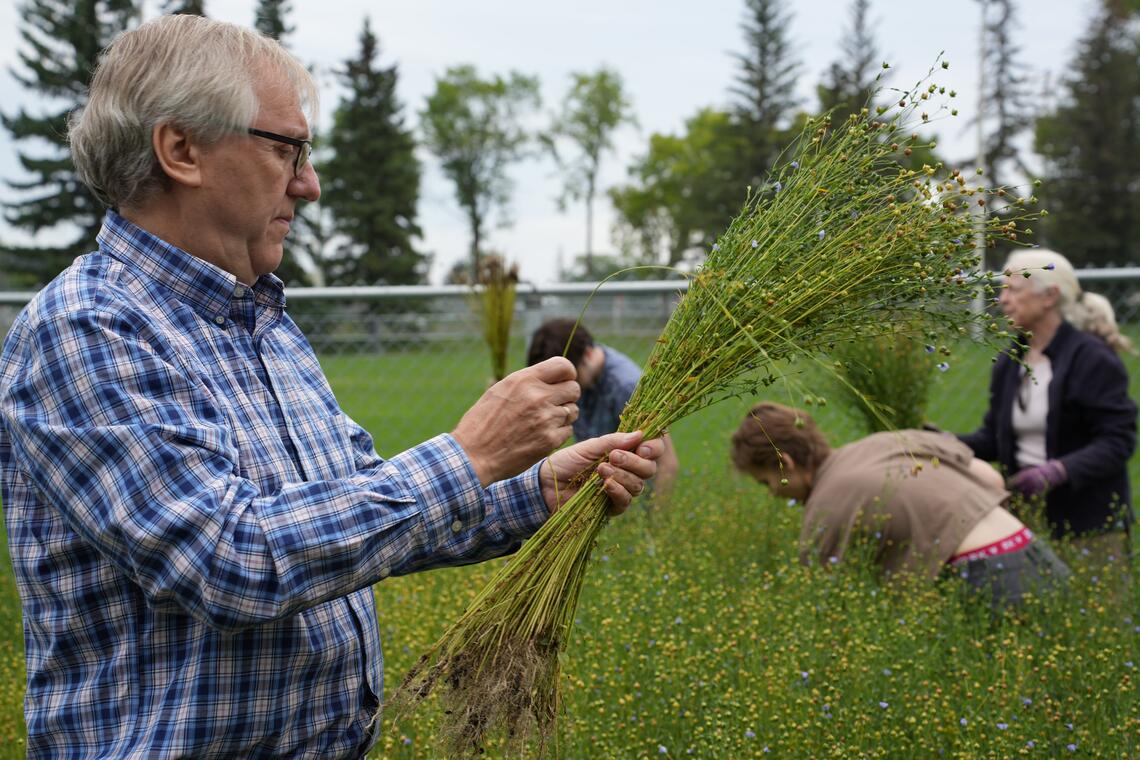June 13, 2024
UCalgary English students and volunteers create paper out of flax, enriching their book-making process
Dr. Maria Zytaruk, PhD, of the University of Calgary’s Faculty of Arts has taken students and community volunteers on an almost year-long trip through history — with plants.
While today’s books are primarily made by machine, from 1500 to 1800 all books were created by hand, from paper creation to printing to binding. In the Book Arts Lab on campus, students in the English program often experiment with the book-making process to become closer to and engage with history.
Zytaruk wanted to teach how the process can be made more sustainable and worked with Brian Queen, a community partner who helps in the lab and is an internationally known paper-maker in his own right. They decided growing flax to make paper would be a great experiment and collaborated with the Office of Sustainability's Campus as a Learning Lab initiative to test this experiment in UCalgary's community garden.
“We thought, from a sustainability perspective, if we could grow flax, break down the fibre, make paper pulp from it and then cast sheets, we would have our own local paper source here,” says Zytaruk, a professor in the Department of English.
The group included some former students, a research assistant in the book lab, as well as some seniors from the bookbinding guild, and alumni. They have now fully completed the process from growing the flax to creating the paper and are looking forward to doing it all over again. The paper made this year will be used by students in the Book Arts Lab. But what were the steps they took to get here?
1. Planting and caretaking
Flax growing in the summer of 2023.
Becca McInnes, Communications
The project began with leftover seeds donated from the University of Western Ontario dating back to the 1990s when it also engaged in growing flax to make paper. The seeds were then planted on two plots in the UCalgary Community Garden. The flax sprouted within six days of their planting in late May 2023, and the students and volunteers spent the rest of the summer watering, weeding and maintaining the plots.
2. Harvesting

Harvesting the flax in September 2023.
Becca McInnes, Communications
The volunteers came together to help harvest the flax over Labour Day weekend the following September, a process that required pulling it up from its roots. They then stored the flax for a few months to allow it to dry.
3. Processing

Processing the flax in a flax break in November of 2023.
Becca McInnes, Communications
A group of volunteers gathered to process the flax using a device called a flax break to break its fibre. They then combed the fibres to prepare them for use. From there, they further broke the fibres down and beat them into pulp.
4. Making paper
Brian Queen, right, creates paper from flax for donors to the Book Arts Lab, Ian and Mary-Ann Watson, in March 2024.
Becca McInnes, Communications
At the beginning of the process, the group only expected that their crop would yield around 10 pieces of paper; they were pleasantly surprised to find they underestimated how well their crop would do and now believe they will be able to make around 100 small sheets.
They created the sheets in March by mixing the flax pulp with water. They then dipped a mould into the pulp and water mixture and shook the pulp onto it until the fibres joined together in a sheet. They then pressed the sheet onto a piece of felt and hung the sheets for several days to dry.
Looking to a new season
Because of the success of the first trial, Zytaruk and her spring book arts class have just planted a new crop of flax and are trying out some new varieties along with seeds from last year. There were four varieties of flax seeds donated last year and, of those, two did much better than the others and so will be the only varieties planted this year.
Zytaruk says she has really valued the conversation and opportunity to educate over the last year through the connections made within the community garden.
“It led to this longer discussion of where paper used to come from, and so it was all these side conversations happening in the garden where our research and the sustainable history of paper-making (was brought to the public),” she says.
Email Maria Zytaruk at mzytaruk@ucalgary.ca if you’d like to participate in this year’s harvest.
The Book Arts Lab is an experiential maker-space in the Department of English devoted to the histories and futures of the book. Students learn to make paper by hand, practise letterpress printing, and bind books in the techniques of the hand-press period. The Book Arts Lab has been generously funded by Ian and Mary-Ann Watson, and our community partner is the Calgary Chapter of the Canadian Bookbinders and Book Artists Guild.







